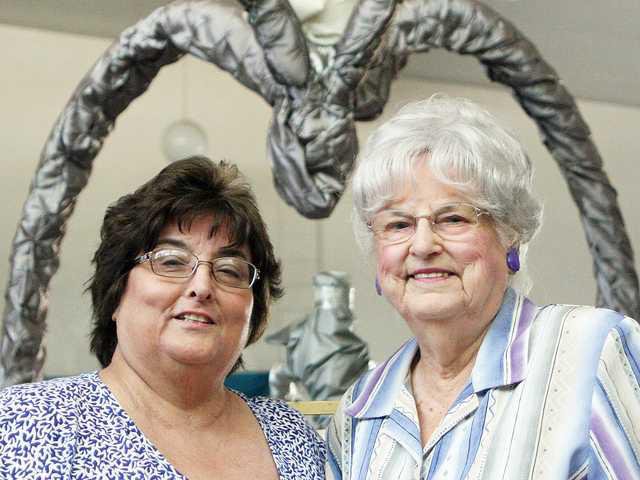Mabel Teicheira is a mother of two, the grandmother of three, and great-grandmother of nine.
But that’s not the nonagenarian’s only claim to local fame. The 93-year-old widow was also a queen twice over – Portuguese Holy Ghost festa queen, that is.
The first time she reigned over the religious and cultural celebration for FESM – Festa do Espirito de Manteca – was in 1932. She was only 12 years old. Four years later, in 1936, she was again the reigning FESM queen.
The first year she was festa queen, it was by virtue of the fact her father was the organization’s president, a part of this celebration’s tradition that continues to this day. The second time around, Teicheira earned her queen title. In 1936, selection of the girl who would serve as queen of the festivities was based on who was going to sell the most tickets in a fund-raiser conducted that year. Teicheira won hands down.
“I sold the most tickets at 10 cents a ticket,” recalled the great-grandmother with a chuckle as she helped in the hectic preparation for the past weekend’s festa on Friday at the MRPS Hall.
MRPS queen is family tradition
As is the case with many multi-generational Portuguese families in the area, the queen title did not end with Mabel. It was, in fact, just the beginning.
In 1963, daughter Janet took her turn as festa queen. The latest in the family to ascend to the title is great-granddaughter Breanna Nunes who reigned over the MRPS festa celebration this past weekend.
Just like her father, Mabel’s late husband, Tony, also served as president of the Manteca-Ripon Pentecost Society. She was just a teen-ager and attending Manteca Union High – which later became Manteca High School – when they got married.
“At one time, he was the Melon King of Manteca,” Mabel said with a big grin. Besides watermelons, he also raised pumpkins and casabas, among other crops. They were blessed with two sons, John who lives in Manteca, and Bob who resides in Los Banos. They had only one daughter, Janet.
Mabel said her husband went into farming after working at the Manteca Cannery for 32 years.
“I was a junior when I quit school to get married,” and to go to work, Mabel smiled.
She got a job at an almond huller and got paid 25 cents an hour. That was a pretty good salary for that time considering bread was five cents a loaf, she recalled.
Even though she did not graduate from Manteca High, she has religiously attended the multi-year class reunions held every year. At the last reunion, she sat with the members of the class of 1938. She was the only one from her class who was there, “so I sat with the 1937 and 1939 graduates,” Mabel said. The oldest that she recalled being there was 94-year-old Paul Valverde.
Original MRPS Hall had dirt floors
As she helped the volunteers decorate the MRPS Hall on Friday for the weekend festa, Mabel’s memory traveled back in time during the early years of Portuguese festa celebrations in Manteca. She remembered, for example, when MRPS Hall on North Grant Street was just a humble box building with a dirt floor that was covered with sawdust during the celebrations.
Although the hall was much smaller then, attendance was nearly five times larger than the average 1,000 guests that the festa is attracting today, Mabel said.
“In 1923, there were 4,500 people at the festa when we had the old building,” she said.
And everyone, then as now, had sopas, the traditional Portuguese soup that is served at all festa celebrations. Those who cannot come to the hall, such as the homebound or care home residents, have the free food delivered to them by festa volunteers.
The food is served free of charge because the meat and some of the other ingredients are donated by local farmers. That is in keeping with the religious aspect of the celebration which goes back to St. Isabel of Portugal’s kindness to her people, feeding them bread during a time of famine in the 1600s which was the direct result of a long drought.
Mabel noted that in the early days of the festa celebrations, they slaughtered three or four times the number of donated cows that they are getting today.
“We had 150 cows, mostly calves,” she said of the number of animals that were donated back during the days when she was festa queen. “Now we have maybe 40 or 50 at the most.”
“We used to get more people at the festa,” Mabel recalled with nostalgia.
They are seeing fewer people these days “because there are so many things going on today,” she hazarded a guess.
“Things change from generation to generation. People are occupied with other things,” rejoined her daughter Janet.
“There are too many other activities happening” that impact the festa attendance these days, added Jody Correia who is serving as MRPS co-president for the second year in a row with husband John.
There are soccer games, graduations, and sometimes, the annual San Joaquin County Fair would happen at the same time, Jody Correia said.
“But people still come. Now, we serve sopas to maybe 1,000 people,” she said.
Serving as MRPS queen a Teicheira family tradition



